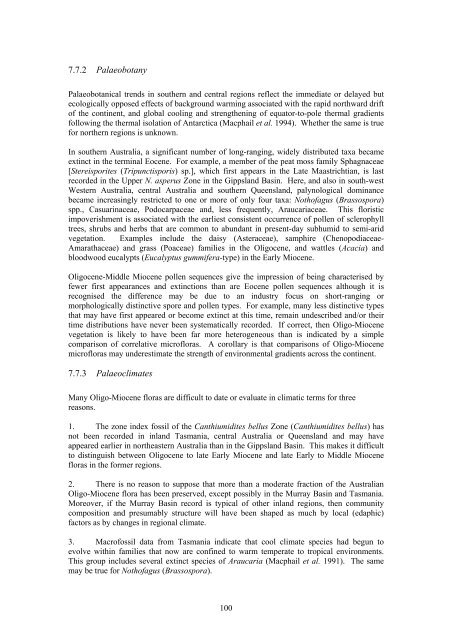OFR 151.pdf - CRC LEME
OFR 151.pdf - CRC LEME
OFR 151.pdf - CRC LEME
You also want an ePaper? Increase the reach of your titles
YUMPU automatically turns print PDFs into web optimized ePapers that Google loves.
7.7.2 Palaeobotany<br />
Palaeobotanical trends in southern and central regions reflect the immediate or delayed but<br />
ecologically opposed effects of background warming associated with the rapid northward drift<br />
of the continent, and global cooling and strengthening of equator-to-pole thermal gradients<br />
following the thermal isolation of Antarctica (Macphail et al. 1994). Whether the same is true<br />
for northern regions is unknown.<br />
In southern Australia, a significant number of long-ranging, widely distributed taxa became<br />
extinct in the terminal Eocene. For example, a member of the peat moss family Sphagnaceae<br />
[Stereisporites (Tripunctisporis) sp.], which first appears in the Late Maastrichtian, is last<br />
recorded in the Upper N. asperus Zone in the Gippsland Basin. Here, and also in south-west<br />
Western Australia, central Australia and southern Queensland, palynological dominance<br />
became increasingly restricted to one or more of only four taxa: Nothofagus (Brassospora)<br />
spp., Casuarinaceae, Podocarpaceae and, less frequently, Araucariaceae. This floristic<br />
impoverishment is associated with the earliest consistent occurrence of pollen of sclerophyll<br />
trees, shrubs and herbs that are common to abundant in present-day subhumid to semi-arid<br />
vegetation. Examples include the daisy (Asteraceae), samphire (Chenopodiaceae-<br />
Amarathaceae) and grass (Poaceae) families in the Oligocene, and wattles (Acacia) and<br />
bloodwood eucalypts (Eucalyptus gummifera-type) in the Early Miocene.<br />
Oligocene-Middle Miocene pollen sequences give the impression of being characterised by<br />
fewer first appearances and extinctions than are Eocene pollen sequences although it is<br />
recognised the difference may be due to an industry focus on short-ranging or<br />
morphologically distinctive spore and pollen types. For example, many less distinctive types<br />
that may have first appeared or become extinct at this time, remain undescribed and/or their<br />
time distributions have never been systematically recorded. If correct, then Oligo-Miocene<br />
vegetation is likely to have been far more heterogeneous than is indicated by a simple<br />
comparison of correlative microfloras. A corollary is that comparisons of Oligo-Miocene<br />
microfloras may underestimate the strength of environmental gradients across the continent.<br />
7.7.3 Palaeoclimates<br />
Many Oligo-Miocene floras are difficult to date or evaluate in climatic terms for three<br />
reasons.<br />
1. The zone index fossil of the Canthiumidites bellus Zone (Canthiumidites bellus) has<br />
not been recorded in inland Tasmania, central Australia or Queensland and may have<br />
appeared earlier in northeastern Australia than in the Gippsland Basin. This makes it difficult<br />
to distinguish between Oligocene to late Early Miocene and late Early to Middle Miocene<br />
floras in the former regions.<br />
2. There is no reason to suppose that more than a moderate fraction of the Australian<br />
Oligo-Miocene flora has been preserved, except possibly in the Murray Basin and Tasmania.<br />
Moreover, if the Murray Basin record is typical of other inland regions, then community<br />
composition and presumably structure will have been shaped as much by local (edaphic)<br />
factors as by changes in regional climate.<br />
3. Macrofossil data from Tasmania indicate that cool climate species had begun to<br />
evolve within families that now are confined to warm temperate to tropical environments.<br />
This group includes several extinct species of Araucaria (Macphail et al. 1991). The same<br />
may be true for Nothofagus (Brassospora).<br />
100

















